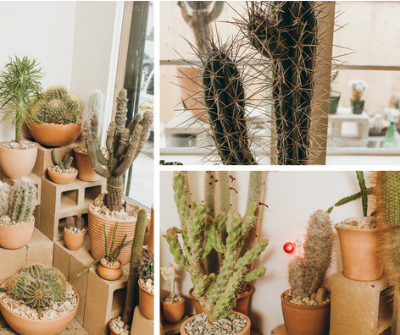For example, he says, “You can have a desert cactus indoors — you have to be very cautious about the amount of light and water. You always want to under-water indoors because you run into the issue of rot when there’s too much water in the soil for too long.” Below, he shares other tips for maintaining artful desert plants at home.
Create an urban oasis — with succulents
For city apartments, the Cactus Store recommends the euphorbia family (these are not technically cacti, but succulents), which can require a bit less light then other varietals and are better suited for indoors. Place plants as close as possible to the window and provide good air circulation, rotating them once a month to ensure even light.
Water sparingly
With indoor cacti, it’s better to under-water, about once a month, rather than over-water. A cactus can survive without water for many, many months; but rot is an instant killer. Using a moisture meter will eliminate all the guesswork; otherwise, you can water whenever the soil is completely dry.
Find a spot in the sun
If you can, leave your cacti outside during the growing months, from March to September, for a
happier, more robust look. (Be careful to introduce them to their new outdoor conditions gradually, otherwise they can get sunburned.) Return the rejuvenated plants indoors for the winter, when they can go dormant.
Drainage is key
Make sure to have a pot with drainage at the bottom, and include an inch of pumice or a small rock to aid in it.
Soil matters
Cacti do not like to sit in wet soil — or regular potting soil. Use only a specialized cactus mix, and after repotting in the new soil, do not water for two weeks. Planting typically breaks a cactus’s roots, and you don’t want to expose cut roots to water, as it can create rot.
Watch for warning signs
Early detection, and action, is a must:
- Thinning of the top growth means not enough light.
– Yellow scarring or splotches of extremities exposed to bright sun can mean sunburn.
– Thinning of overall cactus ribs means under-watering.
– White clumps or scale means insect infestation.
Source: www.nytimes.com






also happening with this paragraph which I am reading now.
casino en ligne
Hi there just wanted to give you a quick heads up.
The text in your post seem to be running off the screen in Safari.
I'm not sure if this is a format issue or something to do with web browser compatibility but I figured I'd post to let you know.
The layout look great though! Hope you get the problem fixed soon. Many thanks
casino en ligne
Thanks for your marvelous posting! I genuinely enjoyed reading it,
you might be a great author. I will make sure to bookmark your blog and
will come back later in life. I want to encourage you continue your great work, have a nice
weekend!
casino en ligne
You have made some decent points there. I looked on the net for additional information about the issue and
found most people will go along with your views on this web
site.
casino en ligne
I think the admin of this site is genuinely working hard for his
site, because here every data is quality based data.
casino en ligne
Paragraph writing is also a excitement, if you be familiar
with afterward you can write or else it is complicated to write.
casino en ligne
Can you tell us more about this? I'd care to find out more details.
casino en ligne
Do you have a spam problem on this website; I also am a
blogger, and I was wanting to know your situation; many of us have developed
some nice practices and we are looking to trade methods with other folks, be sure to shoot me an e-mail if interested.
casino en ligne
Hello there! I just want to give you a huge thumbs up for the
great info you have got right here on this post. I will be
returning to your site for more soon.
casino en ligne
Hi to every one, the contents existing at this
web page are actually amazing for people knowledge, well,
keep up the nice work fellows.
casino en ligne